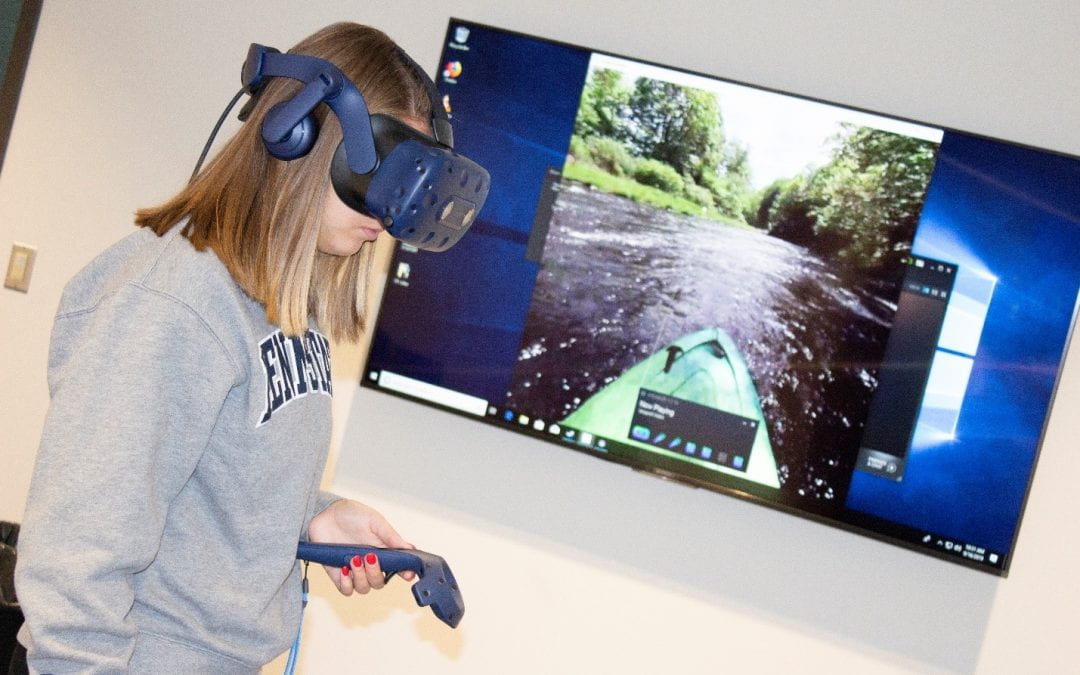
Immersive technology brings environmental field trips to Scranton classrooms
What if you could skip the field trip and virtually transport yourself to any environment? For many, this may be more of a necessary reality amid the COVID-19 pandemic, and Theresa Black, a science lecturer at Penn State Scranton, is ahead of the curve.
“With 360-degree video, you learn different ways to engage your students,” Black said. “Over the last year, I have learned a lot about the various technologies we can use, which has been especially helpful with the campus shut down. I feel comfortable enough to be able to use it again if we end up having a similar situation in the fall.”
In recent years, immersive technology has been an excellent teaching tool for faculty, who can receive support through Media Commons, a Penn State Teaching and Learning with Technology service. Media Commons helps faculty incorporate 360-degree video into their courses in ways that seamlessly integrate into their current curriculum.
“The addition of 360-degree video into a class can be transformative,” said Media Commons campus consultant Carla Seward. “It allows faculty to facilitate experiences to which their students may not otherwise have access. The technology can help students see different parts of the world and explore various climates and cultures; there are almost no limits.”
During spring 2019, inspired by the Biome in a Box project at Penn State Lehigh Valley, Black reached out to Media Commons to discuss how she could incorporate 360-degree video into her Earth 111 Water: Science & Society course. Seward helped her obtain a 360-degree camera, which Black used both with a tripod and mounted to her kayak, to capture a wetland and a variety of locations along the Lehigh River in Eastern Pennsylvania. Using Adobe Premiere Pro, Black edited her videos into a 10-minute tour of the Lehigh River and a 2.5-minute tour of a wetland.
To view these videos, Black’s 30 students worked in pairs and booked 30-minute appointments at the Scranton campus’s Immersive Lab. Working in pairs assists students who are visually impaired, Black explained, and the availability of a video transcript helps students who are auditory impaired. Students completed short-answer questions after using virtual reality headsets to immerse themselves in the wetland and the Lehigh River. The videos supplemented their lessons about the differences between flowing water and standing water ecosystems, in addition to the variances that occur as a stream moves from its headwaters to its mouth.
Even though the course focuses on earth science, it has a social science component, focusing on the human use of water. Overlaying the video clips, Black voiced tidbits about the history of the Lehigh River, which further enhanced students’ learning.
Black’s students were extremely engaged in the project. For many, it was a fascinating experience, since it was the first time they have used a virtual reality headset. They appreciated how the Immersive Lab allowed them to have real-life opportunities only previously afforded by field trips.
“Having a live view that you can move through and manipulate adds to the learning experience,” said Scranton senior Maggie Podunajec. “Apart from this course, using this technology provides students with experiences and knowledge that they may not otherwise have access to.”
Black plans to continue using these videos in the fall and hopes to capture more environments of which would be difficult to take 30 students to and that they otherwise have never seen in person.
“One thing I would like to do in the future—I’m not sure if it will work out this year with travel restrictions—is create a comparative watershed video in the southwest,” Black said. “We talk a lot in this class about the differences in areas like ours where we have tons of water, and there is a lot of overland flow, compared to places out west, where there’s very little. I would love to do a different experience where they can compare the two and visually experience them.”
Penn State faculty interested in incorporating 360-degree video and other immersive technologies in their courses can contact Media Commons. For resources and examples of 360-degree videos made by Penn State faculty, faculty can visit the Immersive Experiences Lab’s Experience Catalog.
